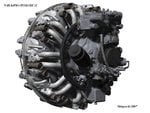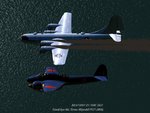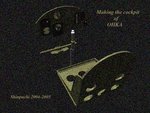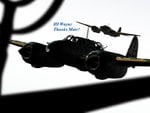- Thread starter
- #121
Navigation
Install the app
How to install the app on iOS
Follow along with the video below to see how to install our site as a web app on your home screen.
Note: This feature may not be available in some browsers.
More options
You are using an out of date browser. It may not display this or other websites correctly.
You should upgrade or use an alternative browser.
You should upgrade or use an alternative browser.
IJA Secret Intelligence Team at Chofu
- Thread starter Shinpachi
- Start date
Ad: This forum contains affiliate links to products on Amazon and eBay. More information in Terms and rules
More options
Who Replied?- Thread starter
- #123
Thank you kaigunair for your post. I'm glad you are fine
I'm not sure if the US pilot was identified or not at this stage.
I'll contact with the Author's side a.s.a.p. as this will be an unavoidable path for the future translation. "There was an incident as a fact but none were identified" will not satisfy the members' interest of this forum.
Your question and opinion are very reasonable.
I'm not sure if the US pilot was identified or not at this stage.
I'll contact with the Author's side a.s.a.p. as this will be an unavoidable path for the future translation. "There was an incident as a fact but none were identified" will not satisfy the members' interest of this forum.
Your question and opinion are very reasonable.
- Thread starter
- #124
Hi, kaigunair. I have contacted with the Author's side(Publisher) today.
Let's look forward to any good reply.
*******************
The followings may concern with the incident.
USAAF Chronology:
PACIFIC OCEAN AREA (POA)
MONDAY, 23 APRIL 1945
AAFPOA (Seventh Air Force): 13 B-24s from Guam Island pound positions on
Marcus Island. The 28th Photographic Reconnaissance Squadron, Seventh AF,
based on Kualoa Airfield, Hawaii with F-5Es, sends a detachment to operate
from Okinawa, the first Seventh AF unit to arrive (another detachment is
operating from Saipan Island).
********************
As you may know, F-5E is a variant of P-38 with no guns
Let's look forward to any good reply.
*******************
The followings may concern with the incident.
USAAF Chronology:
PACIFIC OCEAN AREA (POA)
MONDAY, 23 APRIL 1945
AAFPOA (Seventh Air Force): 13 B-24s from Guam Island pound positions on
Marcus Island. The 28th Photographic Reconnaissance Squadron, Seventh AF,
based on Kualoa Airfield, Hawaii with F-5Es, sends a detachment to operate
from Okinawa, the first Seventh AF unit to arrive (another detachment is
operating from Saipan Island).
********************
As you may know, F-5E is a variant of P-38 with no guns
- Thread starter
- #125
I have had a reply from the publisher by email earlier.
He was politely asking me if he may transfer my question as it is, including my private informations, to the author, Mr. Miyoshi. Of course, I replied 'Yes'.
Is he fine? I don't know but my father is older than him and still fine, very fine. Let's pray.
He was politely asking me if he may transfer my question as it is, including my private informations, to the author, Mr. Miyoshi. Of course, I replied 'Yes'.
Is he fine? I don't know but my father is older than him and still fine, very fine. Let's pray.
Fingers crossed! Hope you get a positive answer....
- Thread starter
- #127
Aaron Brooks Wolters
Brigadier General
May he rest in peace.

- Thread starter
- #129

- Thread starter
- #131
He wrote the story because he would be knowing that his days were numbered.
He was cool
*******************
Here are some other incredible stories which I want to translate around me.
A testimony by a former OHKA(suicide rocket attacker) pilot.
_—‹•"'à
He was ordered to rush several times but fortunately survived because of bad weather.
Mr. Bill Gordon interviewed him to introduce details on his web site.
Home Page of Bill Gordon
Sixty three years after the war look very fast.
He was cool

*******************
Here are some other incredible stories which I want to translate around me.
A testimony by a former OHKA(suicide rocket attacker) pilot.
_—‹•"'à
He was ordered to rush several times but fortunately survived because of bad weather.
Mr. Bill Gordon interviewed him to introduce details on his web site.
Home Page of Bill Gordon
Sixty three years after the war look very fast.
Attachments
Aaron Brooks Wolters
Brigadier General
Looking forward to them.
- Thread starter
- #133
Aaron Brooks Wolters
Brigadier General
I hope it is nothing serious. We can wait if need be. Hope all is well.:angel:
- Thread starter
- #135
Aaron Brooks Wolters
Brigadier General
We wait patiently, until your heart is full again!
- Thread starter
- #138
- Thread starter
- #139
Article No.44
Lockheed P38 Lightning Fighter
==============================
Author: Mr. Teruo Miyoshi
The B29s who had completed their most important mission - bombing - had to endure a long-range flight again back home to the Mariana islands over the vast Pacific Ocean. However, they were sometimes damaged by the flaks or Japanese fighters' assaults and obliged emergency landings on the Iwo-jima island in case they were still flyable or ditched on the ocean.
Anticipating such an incident, the U.S. military was arranging rescue vessels, submarines and another B29 for rescue called 'Super Dumbo' equipped with a life raft in preparation for emergency. Super Dumbo was standing by in a certain airspace until an operation was completed.
The life raft of Super Dumbo was provided with foods, radio equipment and other survival stuff. She was circling on the Pacific for standby until all aircrafts on sortie went back to their base safely. When drifting crew were found, she dropped those rescue supplies and contacted with a rescue vessel or a submarine nearby to save them. About thirty minutes for Super Dumbo, about three hours for a rescue vessel were said enough to arrive at the rescue point.
According to action records of the U.S side, throughout the total air-raid missions over the mainland Japan carried out from the Mariana islands, 596 crew were rescued from 83 B29s. However, those crew who had ditched too near offshore the Japanese mainland were rescued by a submarine who had been standby underwater.
Beside the statistics, I have learned from my recent research that very detailed tactics were condensed for an operation.
Their first principle of respect for human life would be making up such development of tactics.
In old Japanese Army, I feel I may say that they had no consideration for minimizing the risk in withdrawals at all. After the fall of Iwo-jima, the alert airspace of the U.S. military extended further to the north and therefore the standby operation by Super Dumbo became possible. As a result, our patrol area had been overlapped with theirs. We had to be extremely wary in our regular reconnaissance missions.
It was a fine day with the blue sky spreading around our plane and wind was gentle. My partner Sergeant-major T instructed me with his calm voice,
"Two black dots are visible. Check them." I understood his words as "Check the type of U.S. aircrafts."
Observing through the binoculars, I could identify one as B29 with no doubt. The other seemed a fighter but it looked as if two planes were sticking together. I told it to him.
"Two planes couldn't fly sticking together. It will be an Lockheed being controlled by a well experienced pilot transferred from the battle line in Europe. We'll get closer." saying so, he raised the speed.
Since the battle in Europe was about to close, those well experienced pilots were being transferred to the Pacific Theater one after another but, on the contrary, our forces were losing such good pilots one after another. Also, we were suffering from the absolute shortage of necessary number of the military aircrafts. Our interception against them was not enough.
Now the smaller plane was clearly visible.
The type of twin booms.
I had ever seen it on the photograph but never encountered with a real one before.
The Lockheed P38 Lightning fighter of twin-booms with high speed and heavily-armed was also designed for bombing and reconnaissance missions. As its flight range was long, it was able to fly longer to carry out missions.
(Note) URL for the photo and specifications of P38 shall be introduced in the last.
One of their famous war-results to be stated in particular would be 347th Fighter Group based on the Guadalcanal island intercepted and downed our Navy Type 1 Land Attacker(*G4M1 Betty of 705th Air Squadron) in which the commander in chief of the Combined Fleet of the Japanese Navy, Admiral Isoroku Yamamoto was on board.
I hear there has been a conflict at the other side recently saying the pilot who shot down Yamamoto is "Me" and "Me". I wonder if old military men still want to show off their achievements ever.
The P38's role seemed an escort for the B29. It kept flying closely to the bomber. When we approached about 1.25miles to them, our base advised that they had intercepted the communication between the U.S. plane and her base. Their conversation was 'We have encountered with an enemy aircraft alike a patrol plane. How should we do?'. Answer was 'Watch it'.
As they had their own original missions, they would be refraining from a positive action.
Our plane had entered the shooting range but my Sergeant-major was maintaining his calm as if nothing happened and not trying to shoot. B29 gunners would be targetting us. P38 was circling but kept staying between the B29 and us.
I felt the four or five minutes very long and worried a bit how the results were going to be. The P38 pilot was not trying to shoot us, either. He would be a veteran who experienced a lot of battles.
In case of the duel style air-combat, the fear often urged a pilot shooting first but we both were only circling each other with a certain distance interval as if master swordsmen were gazing at each other.
"They have just been ordered 'Rescue mission is over. Return to the base'" our base advised.
When they were just trying to withdraw, Sergeant-major positioned our plane behind the P38 but the opponent did not even turn his head as if he were ignoring us. I wondered if he did not feel any thirst for blood from us. He would have already detected what we were going to do.
"Sergeant-major." I happened to call him.
"I don't shoot. I've just checked his courage." he said with a smile.
I thought the U.S. pilot this time was much different on the skills and courage from the another one of Grumman who was hysterically shooting us on the other day. He might be a veteran of veteran who had fought through many battles with the Messerschmitts(a leading fighter of German Airforce) in the European front.
"This is ---. The two of rescue standby gone home. We home. Present coordinates ---." I reported to the base and our plane turned. However, if I may say it again, I really admired the courage of the U.S. military pilot of the P38 that day...
The photo and specifications of P38 Lightning fighter are posted here.
ttp://chie.okigunnji.com/f/P38/P-38.htm
/End of Article No.44
Lockheed P38 Lightning Fighter
==============================
Author: Mr. Teruo Miyoshi
The B29s who had completed their most important mission - bombing - had to endure a long-range flight again back home to the Mariana islands over the vast Pacific Ocean. However, they were sometimes damaged by the flaks or Japanese fighters' assaults and obliged emergency landings on the Iwo-jima island in case they were still flyable or ditched on the ocean.
Anticipating such an incident, the U.S. military was arranging rescue vessels, submarines and another B29 for rescue called 'Super Dumbo' equipped with a life raft in preparation for emergency. Super Dumbo was standing by in a certain airspace until an operation was completed.
The life raft of Super Dumbo was provided with foods, radio equipment and other survival stuff. She was circling on the Pacific for standby until all aircrafts on sortie went back to their base safely. When drifting crew were found, she dropped those rescue supplies and contacted with a rescue vessel or a submarine nearby to save them. About thirty minutes for Super Dumbo, about three hours for a rescue vessel were said enough to arrive at the rescue point.
According to action records of the U.S side, throughout the total air-raid missions over the mainland Japan carried out from the Mariana islands, 596 crew were rescued from 83 B29s. However, those crew who had ditched too near offshore the Japanese mainland were rescued by a submarine who had been standby underwater.
Beside the statistics, I have learned from my recent research that very detailed tactics were condensed for an operation.
Their first principle of respect for human life would be making up such development of tactics.
In old Japanese Army, I feel I may say that they had no consideration for minimizing the risk in withdrawals at all. After the fall of Iwo-jima, the alert airspace of the U.S. military extended further to the north and therefore the standby operation by Super Dumbo became possible. As a result, our patrol area had been overlapped with theirs. We had to be extremely wary in our regular reconnaissance missions.
It was a fine day with the blue sky spreading around our plane and wind was gentle. My partner Sergeant-major T instructed me with his calm voice,
"Two black dots are visible. Check them." I understood his words as "Check the type of U.S. aircrafts."
Observing through the binoculars, I could identify one as B29 with no doubt. The other seemed a fighter but it looked as if two planes were sticking together. I told it to him.
"Two planes couldn't fly sticking together. It will be an Lockheed being controlled by a well experienced pilot transferred from the battle line in Europe. We'll get closer." saying so, he raised the speed.
Since the battle in Europe was about to close, those well experienced pilots were being transferred to the Pacific Theater one after another but, on the contrary, our forces were losing such good pilots one after another. Also, we were suffering from the absolute shortage of necessary number of the military aircrafts. Our interception against them was not enough.
Now the smaller plane was clearly visible.
The type of twin booms.
I had ever seen it on the photograph but never encountered with a real one before.
The Lockheed P38 Lightning fighter of twin-booms with high speed and heavily-armed was also designed for bombing and reconnaissance missions. As its flight range was long, it was able to fly longer to carry out missions.
(Note) URL for the photo and specifications of P38 shall be introduced in the last.
One of their famous war-results to be stated in particular would be 347th Fighter Group based on the Guadalcanal island intercepted and downed our Navy Type 1 Land Attacker(*G4M1 Betty of 705th Air Squadron) in which the commander in chief of the Combined Fleet of the Japanese Navy, Admiral Isoroku Yamamoto was on board.
I hear there has been a conflict at the other side recently saying the pilot who shot down Yamamoto is "Me" and "Me". I wonder if old military men still want to show off their achievements ever.
The P38's role seemed an escort for the B29. It kept flying closely to the bomber. When we approached about 1.25miles to them, our base advised that they had intercepted the communication between the U.S. plane and her base. Their conversation was 'We have encountered with an enemy aircraft alike a patrol plane. How should we do?'. Answer was 'Watch it'.
As they had their own original missions, they would be refraining from a positive action.
Our plane had entered the shooting range but my Sergeant-major was maintaining his calm as if nothing happened and not trying to shoot. B29 gunners would be targetting us. P38 was circling but kept staying between the B29 and us.
I felt the four or five minutes very long and worried a bit how the results were going to be. The P38 pilot was not trying to shoot us, either. He would be a veteran who experienced a lot of battles.
In case of the duel style air-combat, the fear often urged a pilot shooting first but we both were only circling each other with a certain distance interval as if master swordsmen were gazing at each other.
"They have just been ordered 'Rescue mission is over. Return to the base'" our base advised.
When they were just trying to withdraw, Sergeant-major positioned our plane behind the P38 but the opponent did not even turn his head as if he were ignoring us. I wondered if he did not feel any thirst for blood from us. He would have already detected what we were going to do.
"Sergeant-major." I happened to call him.
"I don't shoot. I've just checked his courage." he said with a smile.
I thought the U.S. pilot this time was much different on the skills and courage from the another one of Grumman who was hysterically shooting us on the other day. He might be a veteran of veteran who had fought through many battles with the Messerschmitts(a leading fighter of German Airforce) in the European front.
"This is ---. The two of rescue standby gone home. We home. Present coordinates ---." I reported to the base and our plane turned. However, if I may say it again, I really admired the courage of the U.S. military pilot of the P38 that day...
The photo and specifications of P38 Lightning fighter are posted here.
ttp://chie.okigunnji.com/f/P38/P-38.htm
/End of Article No.44
Aaron Brooks Wolters
Brigadier General
Very interesting Shinpachi, I enjoyed the article, and again it was well worth the wait. Keep up the great work.
Users who are viewing this thread
Total: 1 (members: 0, guests: 1)





